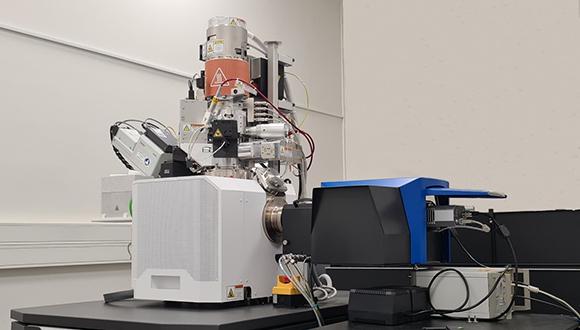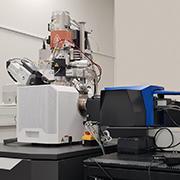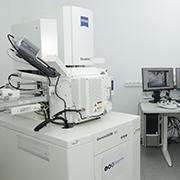APREO HRSEM with Cathodoluminescence
Manufacturer and model:
SPARC cathodoluminescence system (Delmic) on Apreo 2 S LoVac Scanning Electron Microscope (ThermoFisher)
Description:
Apreo 2 S LoVac is a Schottky Field Emission Scanning Electron Microscope (FESEM) that combines high- and low-voltage ultra-high resolution capabilities with special electrostatic lens design together with a low vacuum mode for charge compensation on non-conductive material. The instrument features beam deceleration and unique in-lens detection offering high contrast and versatility to researchers working with a variety of materials and devices. The Apreo FESEM was modified by the manufacturer to hold two optical window laser interfaces for ultrafast laser-stimulated irradiation both at the Electron Gun and Sample Chamber.
Voltage range: 200 eV to 30 keV (20 eV landing energy possible with beam deceleration)
Beam Current range: 1 pA to 50 nA
Additional detectors and accessories on FESEM: retractable backscattered electron detector (BSD), retractable transmission electron microscopy (STEM) detector, Energy Dispersive X-ray Spectroscopy (EDS) UltraDry 129eV 60 mm2 Silicon Drift detector (SDD) detector, in-situ plasma cleaner, Fast Beam Blanker (Max. blanking rate: 1 MHz., Rise/fall time: < 20 ns), Specimen Current/EBIC Amplifier, Leica EM VCT500 Cryo-SEM stage.
The SPARC Cathodoluminescence system is mounted on one flange of the FESEM vacuum system. Light due to electron-specimen interaction is collected by the SPARC parabolic mirror, which is placed between the sample and the column of the electron microscope, and is directed toward the SPARC system. Alternatively, photoluminescence due to sample excitation by the laser could be directed and detected with the SPARC system. Both electron and laser excitations could be simultaneously utilized under this unique FESEM setup.
The laboratory main advantages:
High-end cathodoluminescence (CL) system on high-end high-resolution FESEM with cooling stage. The CL-FESEM provides multiple time-resolved operation modes and multiple detection modes for spectroscopy in visible and IR, angular, and polarization. The SPARC system offers a method to investigate photonic nano- and micro-structures and materials with deep-subwavelength excitation resolution. It can be used to study metallic (plasmonic, Ag, Au, etc.), dielectric (SiO2, Si3N4, TiO2, etc.), and semiconductor (Si, GaAs, CdTe, etc.) micro- and nanomaterials. Laser coupling to the FESEM at the Electron Gun and sample positions further extends the CL research capabilities toward the quantum field.




